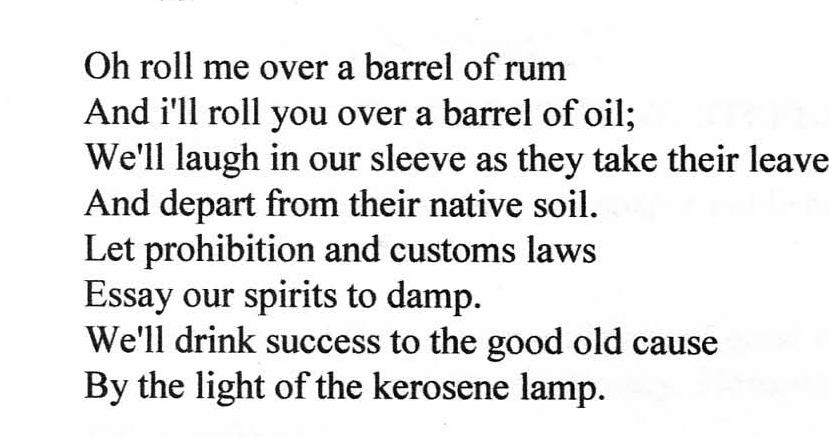
According to St. Stephen historian Doug Dougherty, in the early 1890s the illicit entry of liquor into Calais from St. Stephen and the flow of kerosene in the opposite direction prompted someone to write a song called “Song of the Smuggler”.
This, of course, was decades before the Volstead Act of 1919 ushered the era of Prohibition throughout the United States. In the St. Croix Valley the law was greeted, initially at least, with only mild interest as the valley had been living under Prohibition since 1846 when Maine enacted the first law in the United States prohibiting the sale, manufacture or possession of alcohol and a version of that law remained in effect in Maine thereafter. Maine’s nickname was “The Prohibition State” and national magazine published lurid tales of crime and smuggling across the St. Croix.
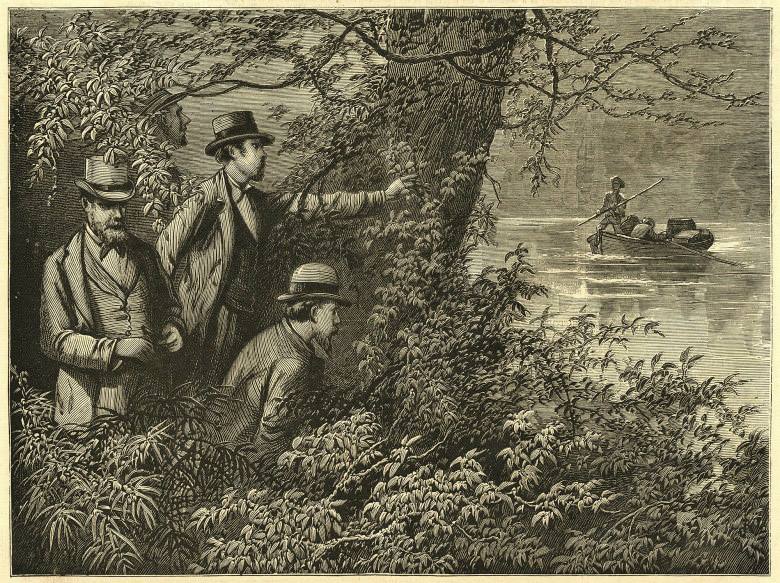
This should not be surprising as the St. Croix Valley was the only place on the North American continent in the those early days where a wet jurisdiction (New Brunswick) and dry jurisdiction (Maine) had a convenient sea border and one on which an already long tradition of smuggling was a way of life. With the advent of the Volstead Act however the stakes became much higher. Not only were Mainers deprived of the right to drink legally but the entire nation was ordered to dry out and sober up, a “Noble Experiment,” it was said, but, as events transpired, an experiment which could only have been devised by either Drs. Jekyll or Frankenstein. Crime flourished, gangsters celebrated Valentine’s Day by massacring rival gangs and millions of ordinary citizens became common criminals every time they entered a speakeasy. Law enforcement was corrupted even in Calais where, according to Louis Morrison who grew up on the Union during Prohibition, Police Chief Bobby Kerr tipped off his bootlegger relatives anytime a raid was planned.
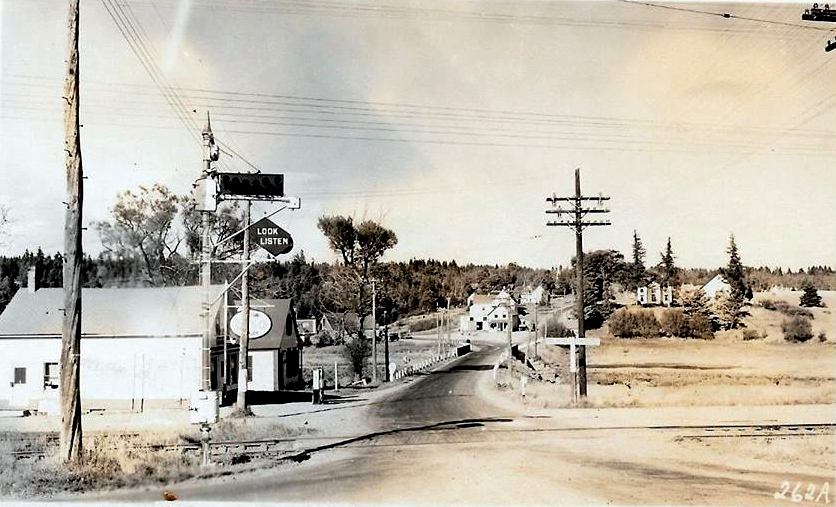
In 1932 a Perry bootlegging operation resulted in the murder of George Talbot in his store. The authorities quickly arrested two fellows from Eastport who had nothing to do with the crime and two young boys from the Boston area who had passed through Perry selling pencils. The Sheriff locked the four up in the Calais jail as suspected murderers. All four were released after a couple of days but those many hours behind bars with a murder charge seemingly likely must have been a traumatic experience. If the authorities appeared inept it is because they didn’t pay sufficient attention to George Talbot’s bootlegging activities, they simply arrested four innocent men because they had been seen in the vicinity of the store on the day of the murder.
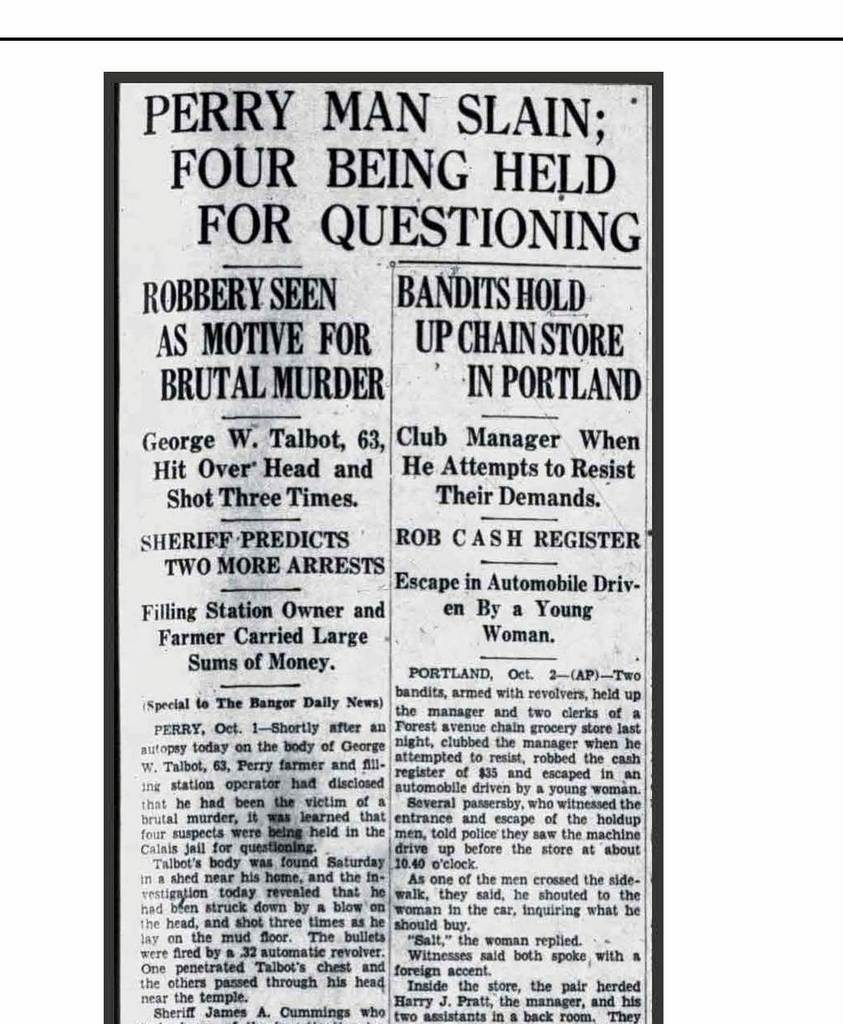
The Bangor Daily reported the crime on October 1, 1932:
October 1st, 1932, Bangor Daily News:
PERRY MAN SLAIN FOUR BEING HELD FOR QUESTIONING ROBBERY SEEN AS MOTIVE FOR BRUTAL MURDER
George W Talbot 63 Hit Over Head and Shot Three Times
SHERIFF PREDICTS TWO MORE ARRESTS
Filling Station Owner and Farmer Carried Large Sums of Money
Special to The Bangor Daily News PERRY Oct 1-
Shortly after an autopsy today on the body of George W. Talbot 63 Perry farmer and filling station operator had disclosed that he had been the victim of a brutal murder it was learned that four suspects were being held in the Calais jail for questioning.
Talbot’s body was found Saturday in a shed near his home and the investigation today revealed that he had been struck down by a blow on the head and shot three times as he lay on the mud floor. The bullets were fired by a 32 automatic revolver. One penetrated Talbot’s chest and the others passed through his head near the temple.
Sheriff James A. Cummings who took charge of the investigation tonight made it known that Henry W. Newth and Wilfred J Lambert of Lewiston and Bernard Collins and a youth named Dunbar of Eastport were being held for further questioning. He said that he believed that the motive for the slaying was undoubtedly robbery and indicated that there would be more arrests tomorrow.
It is alleged that all four of the men now being held had been seen at Talbot’s filling station Saturday. Talbot was known to have carried large sums of money around in his pockets and persons interviewed here today reported that he had a large roll of bills in his possession as late as Friday. Only a five-dollar gold piece was found in his clothing.
Talbot was found slain Saturday by Raymond McPhee who had called at the filling station and found it locked. He then went to the house and called to Talbot.
Failing to get any response he entered the shed where he discovered the body lying on its back on the floor.
Sheriff Cummings and Police Harry Spear of Eastport were called and soon discovered that despite the fact that Talbot had several rifles and shotguns in his home the shooting had not been committed with any one of them. Sheriff Cummings immediately ordered the autopsy, and this was performed by Dr. Willard H. Bunker, Washington County medical Examiner in Calais today.
Due to the fact that Talbot had served two State and one Federal sentence for violation of the Prohibition laws it was first believed that he might have been slain because of bootlegging activities. Later investigation revealed he had but one $5. gold piece in his clothing and a checkup with Perry residents bore out the fact that he was known to have a sizeable roll of bills in his possession as late as Friday.
Sheriff Cummings then started investigating the crime with robbery as a motive for the slaying and arrested Newth, Lambert, Collins and Dunbar who are lodged in the Calais jail.
Talbot returned to this state from California two years ago and for some time had conducted a filling station in connection with his work about the farm. He is survived by a wife and child who are now living in California and was reported to be living alone of late. An Indian Woman, Mrs. Florence Barnard, who is employed as his housekeeper, left three months ago.
Talbot, with the exception of some time he spent in California, has always resided in the house in which he was slain. His trip to California, it is said, was a hurried one. He left his home by one door as the Sheriff was entering another to arrest him on a charge of violating liquor laws.
The arrest of the Massachusetts boys caused a stir in the Boston area. The Boston Globe reported on October 4th, 1932 that, while the two Eastport suspects had been released a “number of discrepancies in the stories of Henry W. Newth and Wilfred J. Lambert, both of Lynn, had made it advisable that they be held further.”
However, it soon became apparent that whatever they were up to in Perry besides “selling pencils” and both had criminal records in Lynn and Haverhill Mass they had not killed George Talbot. The Sheriff been looking for new suspects and finally began to focus on the victim’s current trade-bootlegging.
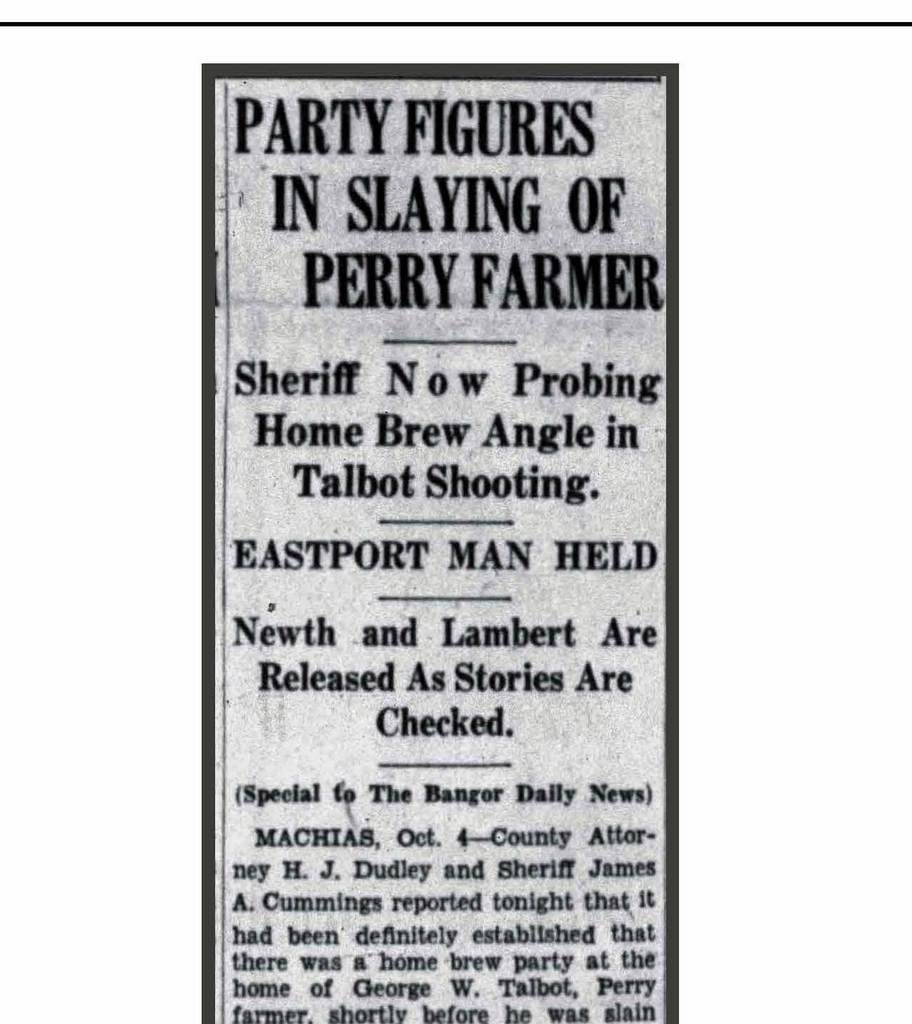
Bangor Daily October 5, 1932
PARTY FIGURES IN SLAYING OF PERRY FARMER
Sheriff Now Probing Home Brew Angle in Talbot Shooting
EASTPORT MAN HELD
Newth and Lambert Are Released As Stories Are Checked
Special to The Bangor Daily News MACHIAS Oct 4
County Attorney H.J. Dudley and Sheriff James A. Cummings reported tonight that it had been definitely established that there was a home brew party at the home of George W. Talbot Perry farmer shortly before he was slain Saturday and revealed that a fifth man had been picked up and was being questioned in the case. He is John Brown 36 of Eastport and is alleged to have been present with others in the Talbot place shortly before the shooting.
Henry W. Newth of Lynn Mass and Wilfred J Lambert of Lewiston who had been held for questioning since Saturday were released today when stories they told were checked up and proven correct. Two Eastport youths also questioned on Sunday were reported to be definitely out of the case.
Sheriff Cummings said last night that he believed that Talbot had been robbed after three bullets had been discharged into his body but was of the opinion that another motive in addition to robbery might have figured in the shooting. He said that officials had determined that there had been a home brew party at the Talbot residence within a few hours of the shooting and was reasonably certain that Brown had been present at that party. Beyond this Sheriff Cummings would not talk and he denied that he was investigating a story that a man had delivered a quantity of alcohol at the Talbot home earlier in the day to return later and quarrel with the filling station proprietor.
Newth and Lambert who were released yesterday after a story to the effect that they had been at the filling station Saturday morning some hours before the shooting and had not returned after their departure had been proven substantially correct.
Sheriff Cummings said that no charges had been preferred against any of the five men who have so far been detained for questioning in the case. He said that each of the five had been questioned when it was learned that they were in the vicinity of the station Saturday.
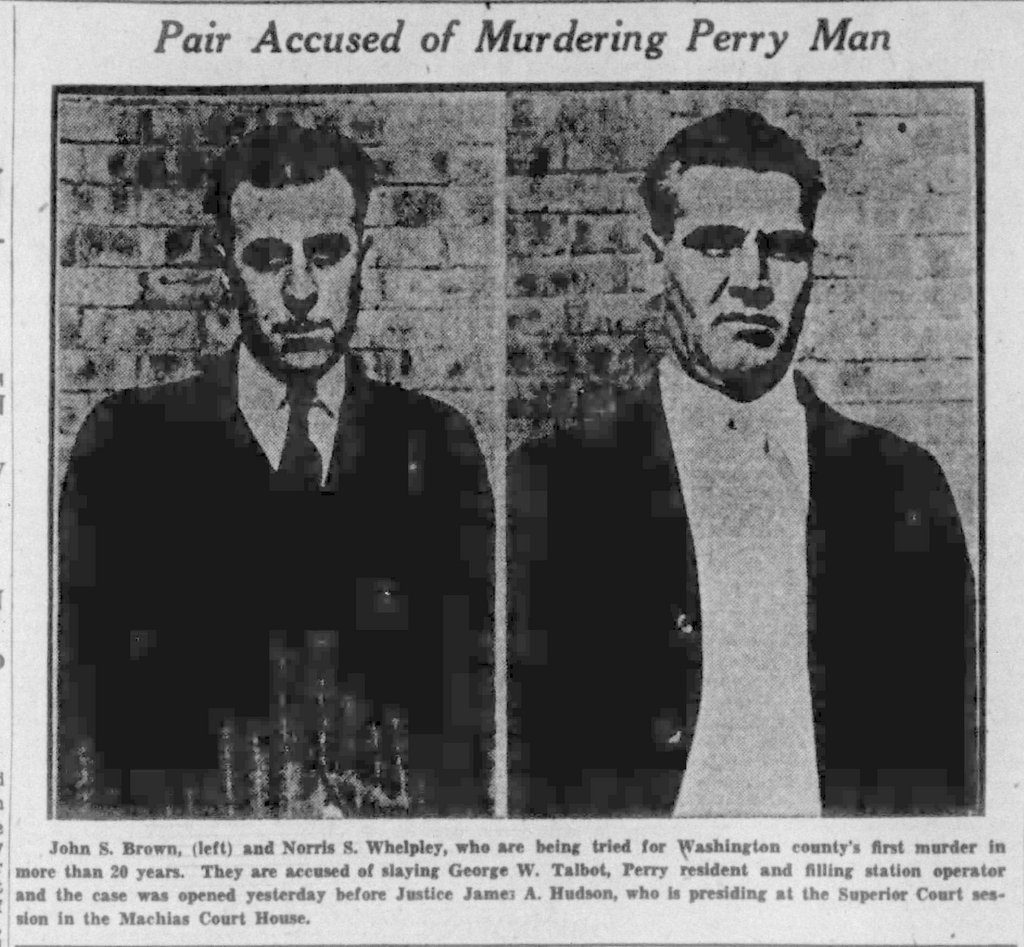
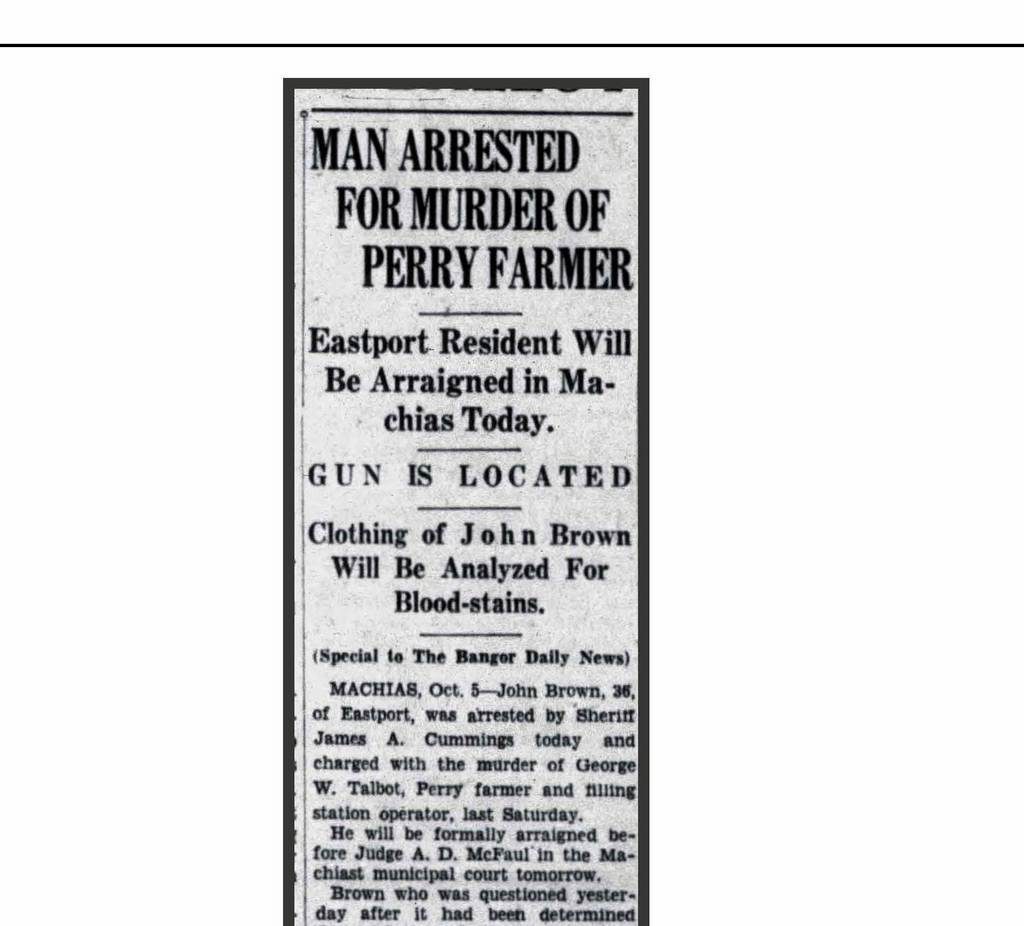
Once on the right track at last the Sheriff was not long in arresting John Brown and Norris Whelpley of Eastport for the murder of George Talbot. Whelpley was not charged initially but soon became a codefendant. The case against them was thin to say the least. They had attended the “Home Brew Party” at Talbot’s store on the day of the murder but so had many others. They both denied the charges and the State’s case seemed to hinge almost entirely on a gun which Brown had borrowed from William Hicks of St. Stephen in what may have been one of the first cases in Maine where forensic evidence was introduced through expert witnesses. Two Boston ballistic experts testified at trial in direct contradiction of one other on whether the Hicks revolver was the murder weapon.
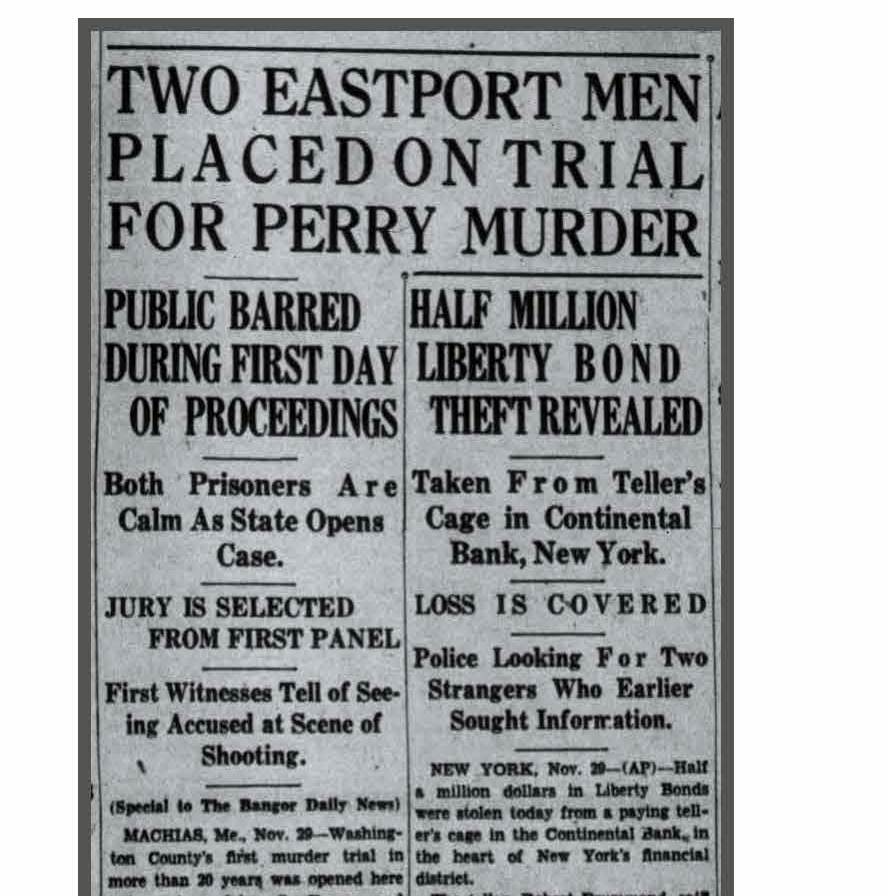
At the end of November 1932, the two went on trial in the Superior Court in Machias. It was the first murder trial in Washington County since 1908 when Nicolas Wallace was convicted of murdering Andrew Higgins, a Baileyville Farmer. According to the Bangor Daily “Interest in the trial is widespread in this section and there were crowds around the Courthouse all day Monday.” As reported by the Bangor Daily at the first day of trial:
County Attorney Dudley, opening for the State, called attention to the fact that it had been 20 years since the County had been compelled to prosecute a murder case, and emphasized to the jury the seriousness of the present case, and it was implied by his address that robbery might have been the motive, as several bills known to have been on the person of Mr. Talbot were missing during the examination of the body following the murder.
The story of the borrowing of the revolver alleged to have been used was then outlined and it was brought out that early in the spring Brown applied for a permit to carry a concealed weapon; borrowing a revolver from William Hicks, subsequently, and failing to return it when requested by the owner. Later the revolver was found to have been given or loaned to Joseph Black of St. Stephen, from whom it was recovered by Sheriff Cummings and soon after with the finding of three bullets and three empty shells near the body, was submitted to Van Amberg of Boston, a well-known ballistic expert, who stated the marks on the shells would have been made by the rebound against the breech block when fired.
Raymond McPhee of Eastport, a Christmas tree buyer, being sworn, stated he had been in Perry on October 1, and that he had stopped at the Talbot store, going inside where he found Brown, Whelpley and some other men. He stated that during his stay there he gave Talbot a $5 bill in exchange for some alcohol and beer, and that the four, himself, Brown, Talbot and Whelpley had a drink each. A short time later they had a second drink, after which he went up the road to the home of Humprey Bogrette and was there about two hours, cruising the pasture looking for trees, and thence to Talbot’s Store, parking there and talking with the same men with whom he had conversed and drank some time before. This was about eleven O’clock on the day of the murder. Again he tendered Mr. Talbot a $5 bill, received his change from Mr. Talbot’s pocket and talked with two other arrivals, Flagg and Patterson. They had some drinks, and then McPhee went home with Patterson four miles towards Calais.
He went back to Talbot’s Store with Ellery Robinson. Going to the store door he found it locked but finding the shed door ajar he pushed it open, went in and through the rooms calling Mr. Talbot’s name but receiving no answer. On his way back his attention was attracted by a man’s foot protruding past a partition and investigating found Mr. Talbot’s body in the shed with the head toward the wall and feet near a post.
Mr. McPhee testified that after he had left the store on his way to Eastport he saw Brown and Whelpley walking in that direction across the ties of the railroad bridge, the traffic bridge being out at the time.
During the second day of trial there was much tedious testimony on the layout of the murder scene, the position of the body and the medical examiner’s testimony:
Entering the shed alone he saw the body of Talbot lying on its back with three bullet wounds in the neck and chest and a bruise near the temple which he stated would have caused unconsciousness while the first of the bullet wounds would in his opinion have been fatal. Dr Bunker told of his subsequent examination and autopsy the latter held at Calais where the top of the skull was lifted, the brain taken out and further examination made of the chest and lung cavity.
He found that two bullets had penetrated the brain and made their exit through the parietal bone, both in the same direction. The bullets were recovered by sifting the dirt and refuse on the shed floor and there were also found three empty and one loaded 32 caliber shells which with the revolver were almost immediately acquired by Sheriff Cummings and which constitute the focal point of the state’s contention that the deed was committed with this weapon and ammunition.
County Attorney Dudley’s intimation that the dead man bad been robbed, while partly borne out by the disappearance of money from the pockets was somewhat offset by Dr Bunker’s statement that be found a five dollar gold piece in a chamois bag in the clothing of Talbot, possibly a memento of his days in California where he resided for some time and where his wife is reported to still be living.
Murray O’Dell, a clam digger from Eastport testified:
that he and his father had gone to dig clams for market at the Eastport end of the railroad trestle when they found themselves too early and sat down to wait for the tide to ebb, it being about half ebb at 3:30 in the afternoon. A checkup showed that it was high water at Eastport that day at 11 a m. While waiting for the tide they saw Brown and Whelpley coming across the trestle as the traffic bridge was impassable and spoke to both as they entered their car on the Eastport side of the water. Whelpley taking the wheel. According to their statement both men were apparently in possession of all their faculties and appeared unflurried or aware that anything had happened in the little town they had just left where a man with whom they had hobnobbed a few hours earlier had died a violent death.
A little diversion was furnished during a quiet period of court, when with a loud protest at confinement, the cork popped out of a bottle in the pocket of a spectator and rolled up the aisle while spectators vainly tried to fasten the blame on their neighbor and ladies in the section sniffed audibly.
The State rested its case on that note and the next day, the last of the trial, both Defendants testified. The Bangor Daily reported their testimony:
Absolute denial of any connection with the killing of George W Talbot at Perry was made on the witness stand in their own defense at last night’s session by John S. Brown and Norris Whelpley of Eastport on trial in the superior court on the charge of murdering Talbot.
They testified that they left Talbot’s home at one 1 o’clock in the afternoon on the day he was shot to death and his body left in the shed and that as they departed a New York automobile containing two strangers one of them selling pencils was still there.
Brown admitted that he had the revolver that has figured in the case and has been the cause of contradictory testimony from ballistic experts called by the prosecution and defense and he admitted that he disposed of it in St Stephen N.B.
He said that he did not learn of the murder of Talbot until 10 o’clock at night when he was in a store in Eastport. Whelpley left the Talbot place with him at one in the afternoon he said and they did not return after that hour.
Evidence on behalf of the respondents was completed at a late hour and the closing arguments and the charge of Justice James Hudson will be in order Monday morning.
According to the Calais Advertiser, Monday was devoted to lengthy closing arguments by the prosecution, the charge to the jury by the judge and brief deliberations by the jury after which everyone, including the Defendants, went home. To be fair to the State, the case had no legs. The initial investigation was botched, several suspects were arrested and released before the Sheriff settled on Brown and Whelpley and even they were seemingly picked out of hat given the number of potential suspects who may visited the bootlegger on the day of the murder. The St Valentine’s Day massacre it wasn’t, but Talbot died in that sleazy underworld of vice and crime created by the “Noble Experiment”. Bootleggers were known to have “sizeable rolls of cash” in their possession and were often the victims of their customers or rivals. The Talbot case was also an expensive one for Washington County. The Boston Globe reported that the trial had cost Washington County ten thousand dollars, the equivalent of over $200,000 today.
